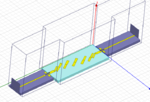Torie
Newbie level 4
- Joined
- Jun 18, 2012
- Messages
- 6
- Helped
- 0
- Reputation
- 0
- Reaction score
- 0
- Trophy points
- 1,281
- Location
- Fort Collins, CO
- Activity points
- 1,328
Hi, I am currently working on a design of a 10% BPF at 130 GHz. I used Ansoft HFSS to do the initial simulations and got very good predicted performance. However, when I measured it, the lower side of the band had an extremely slow roll off. I have gone back to my simulation and added in the wire bonds and the testing structure and I was able to account for a few differences; however, I can't seem to track down the reason why the filter had such a poor performance on the lower end of the pass band. Any suggestions would help! Some sources of error I have already investigated are: tolerances, testing structure, lower conductivity gold, and wire bonding.
<a title="Simulated_Performance.jpg" href="http://obrazki.elektroda.pl/5687909900_1354824668.jpg"><img src="http://obrazki.elektroda.pl/5687909900_1354824668_thumb.jpg" alt="Simulated_Performance.jpg" /></a><a title="Simulation_Pic.png" href="http://obrazki.elektroda.pl/4978662000_1354824669.png"><img src="http://obrazki.elektroda.pl/4978662000_1354824669_thumb.jpg" alt="Simulation_Pic.png" /></a><a title="Performance_Comparison.png" href="http://obrazki.elektroda.pl/3530906600_1354824670.png"><img src="http://obrazki.elektroda.pl/3530906600_1354824670_thumb.jpg" alt="Performance_Comparison.png" /></a>
<a title="Simulated_Performance.jpg" href="http://obrazki.elektroda.pl/5687909900_1354824668.jpg"><img src="http://obrazki.elektroda.pl/5687909900_1354824668_thumb.jpg" alt="Simulated_Performance.jpg" /></a><a title="Simulation_Pic.png" href="http://obrazki.elektroda.pl/4978662000_1354824669.png"><img src="http://obrazki.elektroda.pl/4978662000_1354824669_thumb.jpg" alt="Simulation_Pic.png" /></a><a title="Performance_Comparison.png" href="http://obrazki.elektroda.pl/3530906600_1354824670.png"><img src="http://obrazki.elektroda.pl/3530906600_1354824670_thumb.jpg" alt="Performance_Comparison.png" /></a>
Attachments
Last edited:


